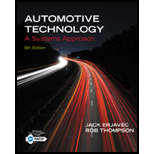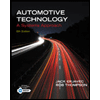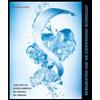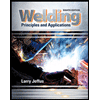
Automotive Technology: A Systems Approach (MindTap Course List)
6th Edition
ISBN: 9781133612315
Author: Jack Erjavec, Rob Thompson
Publisher: Cengage Learning
expand_more
expand_more
format_list_bulleted
Concept explainers
Textbook Question
Chapter 13, Problem 5ASRQ
Technician A says that oil pan gaskets are often made of cork due to its ability to conform to small imperfections in the oil pan. Technician B says oil pan and valve cover gaskets are often MLS gaskets to account for the different expansion rates between components. Who is correct?
- Technician A
Expert Solution & Answer
Want to see the full answer?
Check out a sample textbook solution
Students have asked these similar questions
how are the ( Dismantling and Assembly) of plug valve ? in oil and gas
Technician A says that coolant hoses should be squeezed to check for hardening or softening. Technician B says that coolant hoses should be visually inspected for swelling and cracks. Who is correct?
Water is more dense than cooking oil.
A) TRUE B) FALSE
Chapter 13 Solutions
Automotive Technology: A Systems Approach (MindTap Course List)
Ch. 13 - True or False? Make sure you locate and adhere to...Ch. 13 - How does a torque-to-yield bolt differ from...Ch. 13 - How do seals differ from gaskets?Ch. 13 - Where are thread sealers most often used?Ch. 13 - What are the major differences between aerobic and...Ch. 13 - Which of the following statements is incorrect?...Ch. 13 - True or False? Valve lash is adjusted in many...Ch. 13 - Which of the following statements about the...Ch. 13 - True or False? The computer in most late-model...Ch. 13 - Graphite is. an anaerobic substance an RTV an...
Ch. 13 - Which of the following are considered soft, cut...Ch. 13 - What material is typically not used to form a rear...Ch. 13 - Which of the following statements about preparing...Ch. 13 - On hybrid vehicles, how can you identify the high...Ch. 13 - True or False? Some crankshaft and camshaft timing...Ch. 13 - Prob. 1ASRQCh. 13 - Technician A uses adhesives to hold gaskets in...Ch. 13 - Technician A uses soft gaskets on valve covers....Ch. 13 - Technician A inspects all sealing surfaces for...Ch. 13 - Technician A says that oil pan gaskets are often...Ch. 13 - Prob. 6ASRQCh. 13 - While discussing proper engine break-in:...Ch. 13 - Prob. 8ASRQCh. 13 - Prob. 9ASRQCh. 13 - While selecting the proper RTV for a particular...
Knowledge Booster
Learn more about
Need a deep-dive on the concept behind this application? Look no further. Learn more about this topic, mechanical-engineering and related others by exploring similar questions and additional content below.Similar questions
- While diagnosing the cause of air bubbles in the coolant recovery tank: Technician A checks for a bad head gasket. Technician B checks the radiator cap. Who is correct? Technician A Technician B Both A and B Neither A nor Barrow_forwardWhile discussing the reasons for resurfacing a cylinder head; Technician A says it should be resurfaced to make it flat and very smooth so the head gasket can seal properly during engine assembly. Technician B says that it can be resurfaced to raise the compression. Who is correct? Technician A Technician B Both A and B Neither A nor Barrow_forwardTechnician A says head gasket thickness has an effect on compression ratio. Technician B says connecting rod length has an effect on compression ratio. Who is correct? Technician A Technician B Both A and B Neither A nor Barrow_forward
- When conducting an oil pressure test: Technician A says that lower than normal pressure can be caused by faulty piston oil rings. Technician B says that lower than normal oil pressure can be caused by excessive engine bearing clearances. Who is correct? Technician A Both A and B Technician B Neither A nor Barrow_forwardTechnician A uses adhesives to hold gaskets in place while installing them. Technician B uses RTV sealant on all surfaces that are prone to leaks. Who is correct? Technician A Technician B Both A and B Neither A nor Barrow_forwardWhile discussing the common causes for cracks developing in a cylinder block or head: Technician A says that the chilling of a hot engine by a sudden rush of cold water or air over the surf ace may cause cracking. Technician B says that excessive overheating is a common cause. Who is correct? Technician A Technician B Both A and B Neither A nor Barrow_forward
- While conducting an engine vacuum test; Technician A says that a steady low vacuum reading can be caused by a burned intake valve. Technician B says that an overall low vacuum reading is caused by something that affects all of the engines cylinders. Who is correct? Technician A Technician B Both A and B Neither A nor Barrow_forwardWhile discussing thread sealants and lubricants: Technician A says that antiseize compound is used where a bolt might become difficult to remove after a period of time. Technician B says that thread sealants are used on bolts that are tightened into an oil cavity or coolant passage. Who is correct? Technician A Technician B Both A and B Neither A nor Barrow_forwardTechnician A makes sure that the exhaust system is cool to the touch before working on it. Technician B disconnects the batterys negative cable before welding an exhaust pipe. Who is correct? a. Technician A b. Technician B c. Both A and B d. Neither A nor Barrow_forward
- Technician A says it is not necessary to measure valve stem height unless the valves have been replaced. Technician B says valve stem height can be adjusted with shims. Who is correct? Technician A Technician B Both A and B Neither A nor Barrow_forwardWhich of the following are considered soft, cut gaskets? Paper gaskets Cork gaskets Cork/rubber gaskets All of the abovearrow_forwardIf oil is to be stored at temperatures lower than 20F, A. waxes in the oil can reduce the oil's ability to flow properly. B. kerosene can be added to lower the oil's pour point. C.Both A and B are correct. D. Neither A nor B is correct.arrow_forward
arrow_back_ios
SEE MORE QUESTIONS
arrow_forward_ios
Recommended textbooks for you
 Automotive Technology: A Systems Approach (MindTa...Mechanical EngineeringISBN:9781133612315Author:Jack Erjavec, Rob ThompsonPublisher:Cengage Learning
Automotive Technology: A Systems Approach (MindTa...Mechanical EngineeringISBN:9781133612315Author:Jack Erjavec, Rob ThompsonPublisher:Cengage Learning Automotive TechnologyMechanical EngineeringISBN:9781337794213Author:ERJAVEC, Jack.Publisher:Cengage,
Automotive TechnologyMechanical EngineeringISBN:9781337794213Author:ERJAVEC, Jack.Publisher:Cengage, Refrigeration and Air Conditioning Technology (Mi...Mechanical EngineeringISBN:9781305578296Author:John Tomczyk, Eugene Silberstein, Bill Whitman, Bill JohnsonPublisher:Cengage Learning
Refrigeration and Air Conditioning Technology (Mi...Mechanical EngineeringISBN:9781305578296Author:John Tomczyk, Eugene Silberstein, Bill Whitman, Bill JohnsonPublisher:Cengage Learning Welding: Principles and Applications (MindTap Cou...Mechanical EngineeringISBN:9781305494695Author:Larry JeffusPublisher:Cengage Learning
Welding: Principles and Applications (MindTap Cou...Mechanical EngineeringISBN:9781305494695Author:Larry JeffusPublisher:Cengage Learning

Automotive Technology: A Systems Approach (MindTa...
Mechanical Engineering
ISBN:9781133612315
Author:Jack Erjavec, Rob Thompson
Publisher:Cengage Learning

Automotive Technology
Mechanical Engineering
ISBN:9781337794213
Author:ERJAVEC, Jack.
Publisher:Cengage,

Refrigeration and Air Conditioning Technology (Mi...
Mechanical Engineering
ISBN:9781305578296
Author:John Tomczyk, Eugene Silberstein, Bill Whitman, Bill Johnson
Publisher:Cengage Learning

Welding: Principles and Applications (MindTap Cou...
Mechanical Engineering
ISBN:9781305494695
Author:Larry Jeffus
Publisher:Cengage Learning
Thermodynamics - Chapter 3 - Pure substances; Author: Engineering Deciphered;https://www.youtube.com/watch?v=bTMQtj13yu8;License: Standard YouTube License, CC-BY